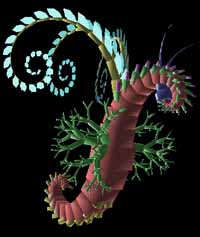Life in Cyberspace
Dateline: 11/03/97
 Ever
since the vision of cyberspace expressed by Neal Stephenson in Snow
Crash, pioneers have dreamed of creating new virtual worlds filled
with "living" beings. Some of these beings are synthetic representations
of real people, known as avatars. Some of these living objects are completely
synthetic - a form of artificial life. Tightly coupled with the VRML community
is a project called Biota.org. Biota
is an official working group of the VRML
Consortium and a Special Interest Group (SIG) of the Contact
Consortium. Another associated project is the Nerves
proposal from the people at DigitalSpace
who are trying to create a language to describe complex behaviors modeled
on biological concepts.
Ever
since the vision of cyberspace expressed by Neal Stephenson in Snow
Crash, pioneers have dreamed of creating new virtual worlds filled
with "living" beings. Some of these beings are synthetic representations
of real people, known as avatars. Some of these living objects are completely
synthetic - a form of artificial life. Tightly coupled with the VRML community
is a project called Biota.org. Biota
is an official working group of the VRML
Consortium and a Special Interest Group (SIG) of the Contact
Consortium. Another associated project is the Nerves
proposal from the people at DigitalSpace
who are trying to create a language to describe complex behaviors modeled
on biological concepts.
The mission of Biota.org is "to create and deploy digital tools and
environments for research and learning about living systems. These tools
could range from simple genetic algorithms all the way up to entire synthetic
ecosystems."
While these concepts may sound a bit "far out" even flaky, they are
pushing the virtual envelope and have the participation and support of
companies such as Silicon Graphics, Sun Microsystems, and Microsoft. The
notion of avatars, a synthetic representation of the self, in a shared
distributed virtual environment (3D chat rooms) is likely to be a driving
application of the future Internet. Conferences such as the recently held
Avatars 97, sponsored
by the Contact Consortium, featured sessions with talks on community building,
standards for avatar cyberspace, kids in digital space, and collaborative
virtual laboratories.
Like any new and emerging field there's a book and an award. Avatars!
by Bruce Damer published by Peachpit Press covers all the major virtual
world environments such as Worlds
Chat, The Palace, Comic
Chat and more. The Avvy
Award is presented for the avatars in the Most Realistic, Best Non-Humanoid,
VRML 2.0 and a few other categories. Personally I can't wait for the day
when a tearful avatar strolls down the promenade catching virtual congratulatory
flowers upon winning such a prestigious award. Presently some of the environments
are 2D worlds and some are 3D, all are interesting.
The technologies necessary to implement these types of distributed interoperable
worlds requires serious, and hard, work. The Living
Worlds working group of the VRML Consortium,
and the Open Community
interface specification being led by Mitsubishi
Electric Research Labs, are addressing the many technical issues such
as interoperability or how can I get my avatar to understand and behave
correctly in your world. Time to go now but let's have my avatar talk to
your avatar and let's do lunch.
Previous
Features
 Ever
since the vision of cyberspace expressed by Neal Stephenson in Snow
Crash, pioneers have dreamed of creating new virtual worlds filled
with "living" beings. Some of these beings are synthetic representations
of real people, known as avatars. Some of these living objects are completely
synthetic - a form of artificial life. Tightly coupled with the VRML community
is a project called Biota.org. Biota
is an official working group of the VRML
Consortium and a Special Interest Group (SIG) of the Contact
Consortium. Another associated project is the Nerves
proposal from the people at DigitalSpace
who are trying to create a language to describe complex behaviors modeled
on biological concepts.
Ever
since the vision of cyberspace expressed by Neal Stephenson in Snow
Crash, pioneers have dreamed of creating new virtual worlds filled
with "living" beings. Some of these beings are synthetic representations
of real people, known as avatars. Some of these living objects are completely
synthetic - a form of artificial life. Tightly coupled with the VRML community
is a project called Biota.org. Biota
is an official working group of the VRML
Consortium and a Special Interest Group (SIG) of the Contact
Consortium. Another associated project is the Nerves
proposal from the people at DigitalSpace
who are trying to create a language to describe complex behaviors modeled
on biological concepts.